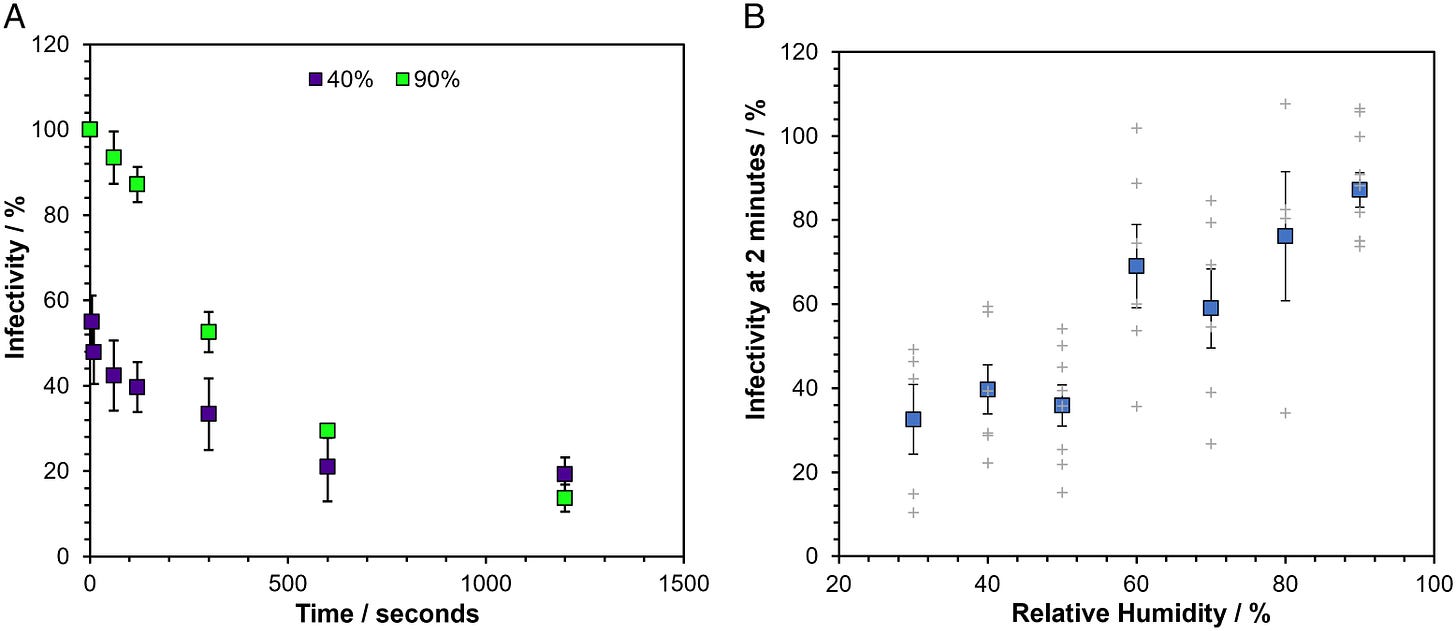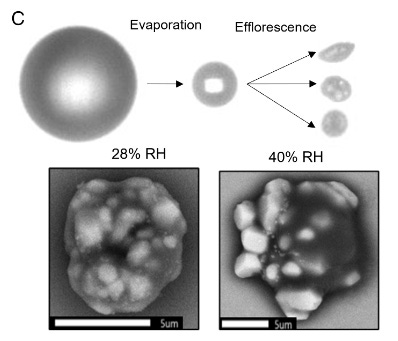Covid Survives For Much Longer Inside Masks
In the right conditions, infectiousness drops 50% within seconds.
Please consider taking out a paid subscription because it enables me to spend longer reporting on the news that isn’t, but should be reported.
A recent study published in the Proceedings of the National Academy of Sciences (PNAS) looked at the dynamics of SARS-CoV-2 infectivity with changes in aerosol microenvironment. To summarise, the study conducted by the University of Bristol, looked at what happens when Covid is exhaled in respiratory aerosol into the surrounding environment.
The authors used an instrument to probe survival in a small population of droplets (typically 5 to 10) containing at least 1 virus per droplet. They measured the results of the droplets over the course of 20 minutes of levitation in bother low (40%) and high (90%) Relative Humidity (RH).
The rest of this article is available as an early read for paid subscribers only. My articles take a lot of time to research and write so your support is very much appreciated and will ensure that I can continue to produce the same quality and quantity of articles going forwards.
They found that in low RH (the purple squares in the chart on the left above), there is a decrease of infectivity of around 54% almost instantly (within 5 seconds). It then decreases at around 19% over the next 5 minutes.
On the other hand, in high RH (green squares), reduction in infectivity was more gradual with loss of infectivity of 48% over the first 5 minutes. Both RHs plateau after 10 minutes and infectivity is almost identical after 20 mins.
After various adjustments (chart on the right), the authors found that between 30 and 50% RH infectivity typically declines to around 30-40% within 2 minutes. At RHs of 80% and above, the virus was far more stable and infectivity rarely fell below 80% after 2 minutes.
Chemical & Engineering News reports that the reason for this drop in infectivity in low RHs is that “the particles undergo a phase change: They crystallize as water evaporate off the aerosols and the salts within them concentrate.”
They also observed that when the pH of aerosol droplets went over 9.5, the infectivity of the virus diminished considerably. Over pH 11 meant that only 7% of the virus remained infectious after 20 minutes whilst in lower pHs there was no significant decrease in infectivity.
Low pH levels were found in exhaled aerosols but once the particles made contact with an environment which was lower in CO2, the change in pressure increased the pH. So environments with higher than average levels of CO2 resulted in pH levels dropping.
So the overall summary is that HIGH CO2 levels result in LOW pH levels which have no effect on infectivity. However, LOW CO2 levels result in HIGH pH levels which rapidly reduce the viruses infectivity.
Furthermore, LOW levels of RH resulted in infectivity dropping very quickly whilst HIGH levels of RH meant much slower drops.
I guess the title gave it away but can you think of an environment with HIGH humidity and HIGH CO2 levels? You got it…masks. The perfect environment for keeping the virus alive. Whilst the study didn’t mention masks, this is surely the logical conclusion?
If two individuals (one masked, one not) are both ill with SARS-CoV-2, well any coronavirus in fact, standing near the masked individual will mean you are more likely to come in contact with infectious virus particles. The unmasked person will be breathing out the same particles but they will lose infectiousness rapidly.
Subscriptions are best but if you would prefer to/ also like to buy me a coffee then click on the button below.








This certainly tracks with the high-mask compliance areas having the same or higher covid spread than the less-masked areas. Fluid dynamics, relative humidity and pH! Thanks!
I knew they are of no benefit and harmful.
The hypoxic nature of masks and the moist environment creates more virus.... upside down world continues........
Thanks and keep up the good work!